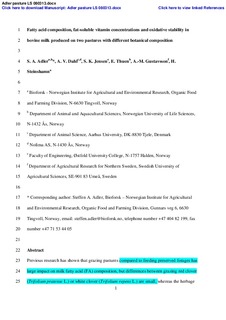| dc.description.abstract | Previous research has shown that grazing pastures compared to feeding preserved forages has large impact on milk fatty acid (FA) composition, but differences between grazing red clover (Trifolium pratense L.) or white clover (Trifolium repens L.) are small, whereas the herbage proportions of dicotyledon botanical families is positively correlated with the milk-fat proportions of total polyunsaturated FA when grazing pastures in the Alps. The objective of the present study was to investigate the influence of botanically different pastures on bovine milk composition and milk susceptibility to oxidation. Two groups of 8 multiparous Norwegian Red dairy cows [mean (standard deviation); 599 (45.1)kg body weight, 73 (15.0)d in milk, 29.9 (2.90)kg milk/d at experiment start] grazed either a short-term pasture (SP) or a long-term pasture (LP). Both pastures were organically managed, meaning that no artificial fertilizers or herbicides were applied. The SP was representative for pastures, which are frequently, i.e. at least every third year, renewed by soil tillage and seeding, whereas LP was representative for pastures, which are less frequently renewed. The SP contained mainly meadow fescue (Festuca pratensis Huds.), timothy (Phleum pratense L.) and red clover and LP contained smooth meadow grass (Poa pratensis L.), white clover and a variety of unsown species. Sixteen cows were blocked according to milk yield, days in milk and sire, and randomly within block allocated to the 2 dietary treatments with a daily pasture allowance of 15–20kg dry matter per cow, supplemented with 3.0kg barley (Hordeum vulgare L.) concentrate. Milk was sampled during the last week of 3 experimental periods and analysed for FA composition by gas chromatography, concentrations of fat-soluble vitamins by high performance liquid chromatography, and oxidative stability in a light-exposure experiment by measuring the formation of hydroperoxides and by front-face fluorescence spectroscopy. Pasture type had no effect on milk yield, milk gross composition, and only minor effects on milk FA composition. Milk from SP had higher concentration of α-tocopherol than LP. The formation of hydroperoxides in milk was lower for SP than LP after 24h light exposure, but no differences were found after 48h. Front-face fluorescence spectroscopy revealed slightly higher formation of components in the area of 409–480nm wavelength for SP than LP, which may be related to milk-lipid oxidation. The experimental pastures differed mainly in herbage proportions of red clover and white clover and less in proportions of non-legume dicotyledons. This explains small differences in milk FA composition and milk susceptibility to oxidation. | nb_NO |

